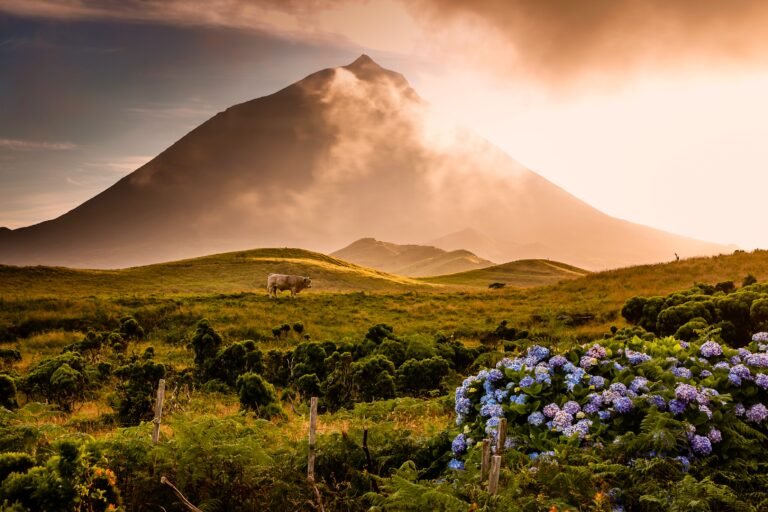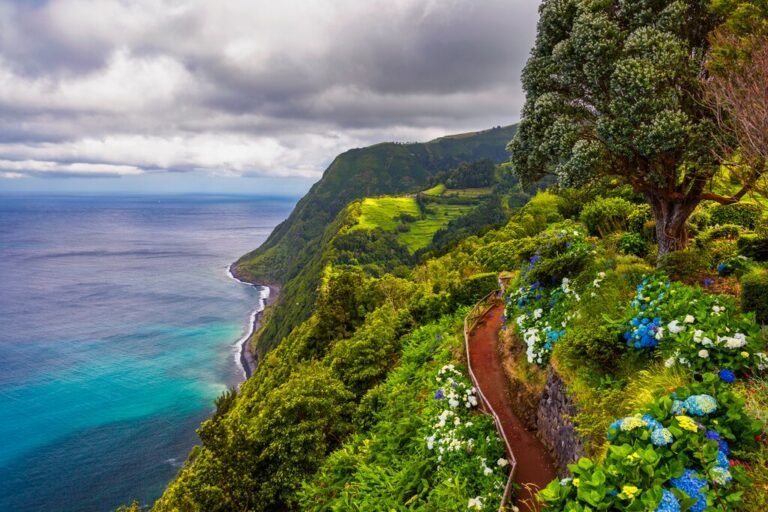Pico 4-Day Itinerary Overview
The island of Pico is perhaps the most interesting of all other nine islands of the Azores archipelago. It’s the second largest in the archipelago, the youngest of all the Azores and the black lava that covers 80% of the island contrasts with the blue of the sea where whales and dolphins live (whom you can greet from a boat). The green of the vineyards, whose landscape is a UNESCO heritage site, is where you can taste a glass of delicious white wine. It’s also a home to the highest mountain in Portugal, called Mount Pico or as locals call it „Piquinho“.
The magnetism of the enormous mountain will draw your gaze to it every day while you’re staying in the central group of archipelago – it is seen from far away. Ascending Mount Pico is for many people the highlight of their visit. Pico Island also boasts the largest lava tube in Portugal (and yes, you can enter it).
And of course, Pico has numerous natural lava pools, where you can refresh yourself after exploring the island or snorkel and admire the marine life as well.
In this 4-day itinerary we’re reflecting all that Pico has to offer. We’ve added practical proposals, tips, where to sleep, and even where to eat.
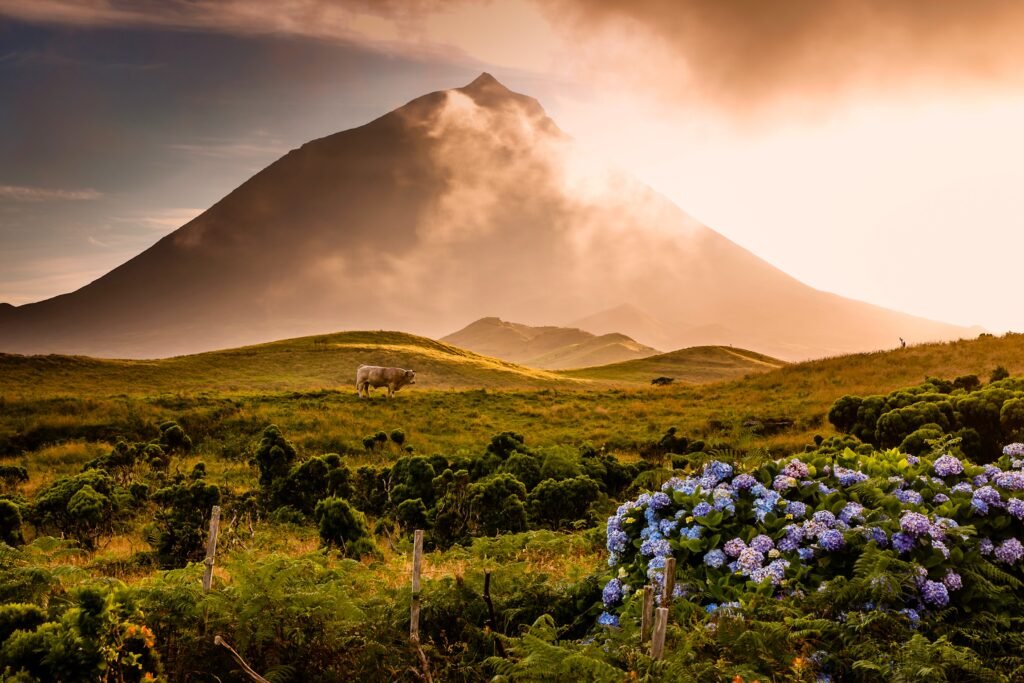
Day 1: Ascending Mount Pico
Day 2: Southern Pico (whale watching tour, bomba volcanica & bolo baleeiro, Museu dos Baleeiros, lunch in Lajes, natural pools, Gruta das Torres, Madalena)
Day 3: Northern & Eastern Pico (Ponta da Ilha Trail, Sao Roque, Sao Antonio, Cachorro, Lajido, Santana Trail)
Day 4: Central Pico (Estrada Transversal and Lagoas, Furna do Frei Mathias, Lagoa do Capitão, Lagoa do Capitão Trail, Sao Roque)
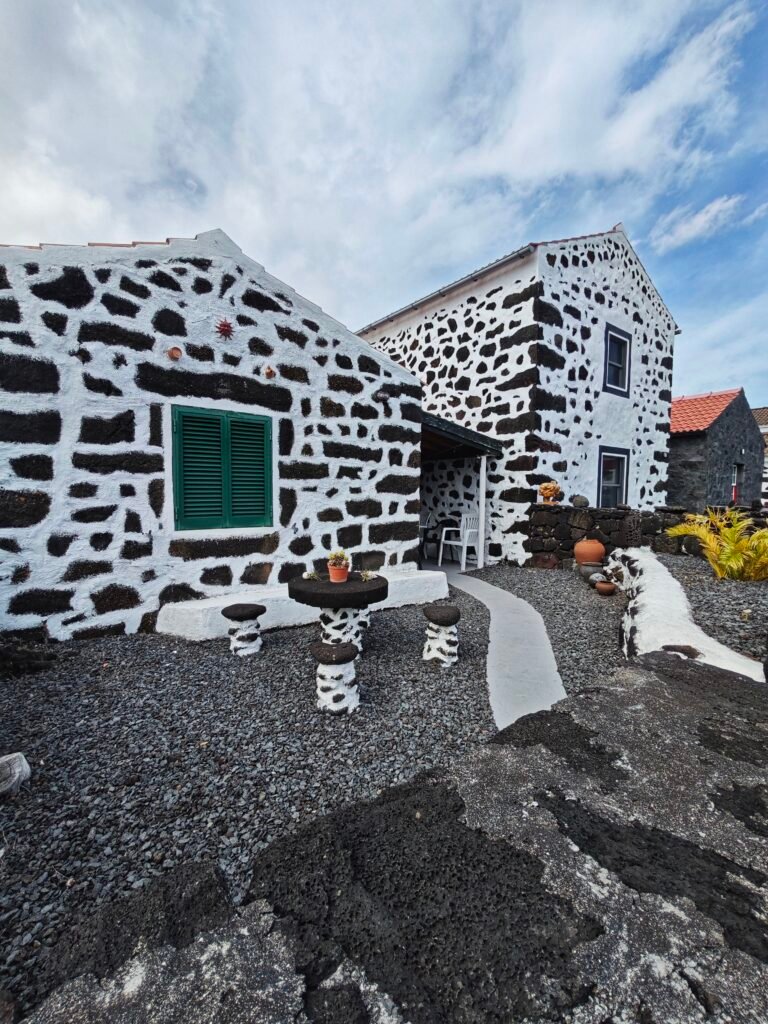
How to Get to Pico?
There are no direct flights to Pico from outside the archipelago so it can only be reached by flying from other islands of the Azores.
The cheapest flights to Azores are usually Ryanair flights from Lisbon/Porto to Ponta Delgada (São Miguel) or Lajes (Terceira) but to get the best price you should be flexible with dates and use price comparators such as Skyscanner and Google Flights.
Pico has an airport, very close to the city of Madalena. If coming by plane you are probably coming from Sao Miguel, or another nearby island such as Terceira. Between islands, flights to Pico are generally made on SATA propeller planes. The airport code is PIX, most airplanes fly in from Ponta Delgada (PDL). NOTE! Each day has a different flight schedule, so make sure to do some research when planning your trip.
So, once in the archipelago, you can reach Pico in two ways:
- By plane with SataAirlines. You can check timetables and prices on the official website of Sata, the regional airline of the Azores.
- By ferry from one of the neighboring islands of the central group:
From São Jorge: every day of the year, 10,50€, 1-hour trip
From Faial: every day of the year, 3,8€, 30-minute trip (boat stops in Pico)
From Terceira, Flores or Graciosa: only in summer, a couple of days per week. From 32€, 3+ hour trip.
You can check ship schedules and purchase tickets in advance at Atlanticoline (although schedules and routes are usually much better explained here).
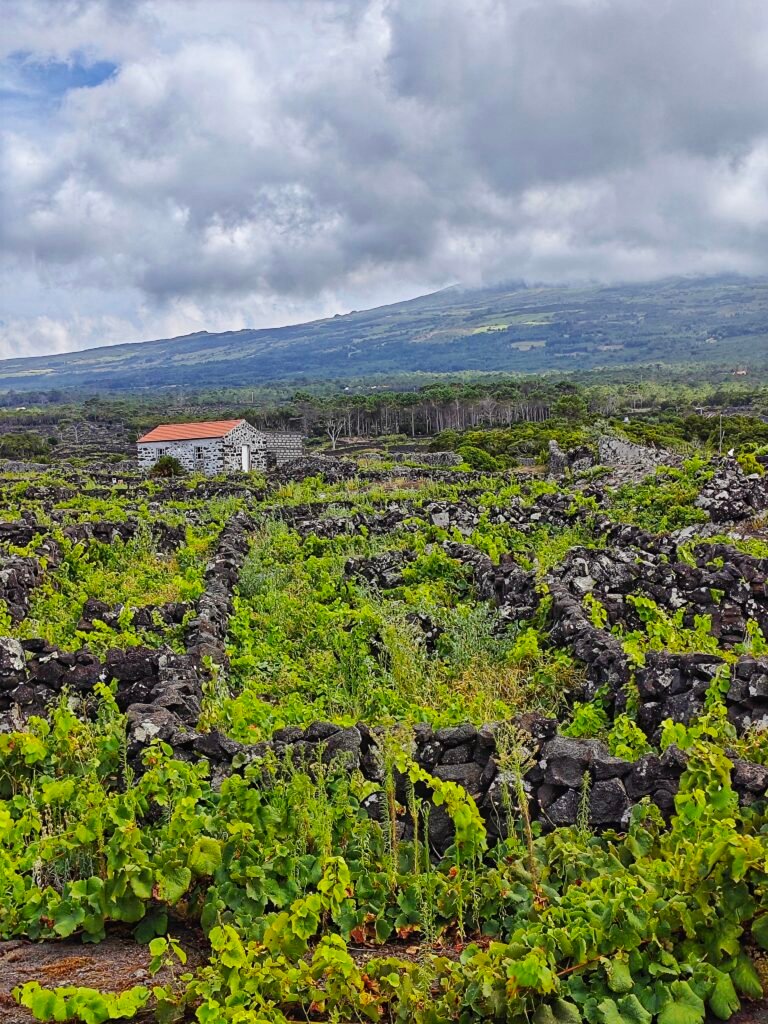
Renting a Car in Pico

The best way to get around the Azores is to rent a car. The process is easy – if you have a valid licence you simply walk into one of the stores and rent-a-car for the day (or two or more). Parking all around island is free of charge and parking lots are spacious and well marked. Driving around is very simple as well since the island itself doesn’t have a lot of traffic and the roads are nice.
I can recommend renting from RentalCars. They have multiple options and are easy to rent at.
NOTE! During the summer months (June, July, August) car prices skyrocket with limited availability. There are also scooter rentals, but oftentimes the higher areas of Pico are covered in fog and have limited visibility.
There are also numerous verified taxi drivers found throughout the island. Many of the hiking trails of Pico are linear (point to point, A –> B), so a taxi driver should be arranged for pick up and drop off. Taxi rentals will cost you anywhere from 80€ to 150€ per day. Note that a taxi can accommodate up to 4 people, vans to up to 8 people, so sharing the expense makes it very affordable.
Pico has an association of taxi drivers that can be found here.
Pico Tours for Those Not Renting a Car
If you are, for any reason, unable to rent a car, I recommend booking different tours to visit various locations around the island. Why? Because with just taking the public transport to go around you’ll see much less and need more time (and nerves). There is very limited public transportation on the island of Pico. It is nearly impossible to rely on buses that run infrequently and stop at limited locations that are often not interesting to tourists – they’re meant for locals. Hence booking a tour is an obvious solution and you’ll get the most for your money.
I took some of the tours myself on my first visit to the Azores – found them to be very affordable and well-managed. Usually lunch is included as well, which comes handy.
Here are some highly rated tours that will help you see a large amount of the sites I listed in this Pico itinerary:
- Wine Tour
- Full Day Guided Tour in Pico Island
- Lakes and Volcanoes (Whole Day)
- Wine & Food Tour
- Other Tours & Activities
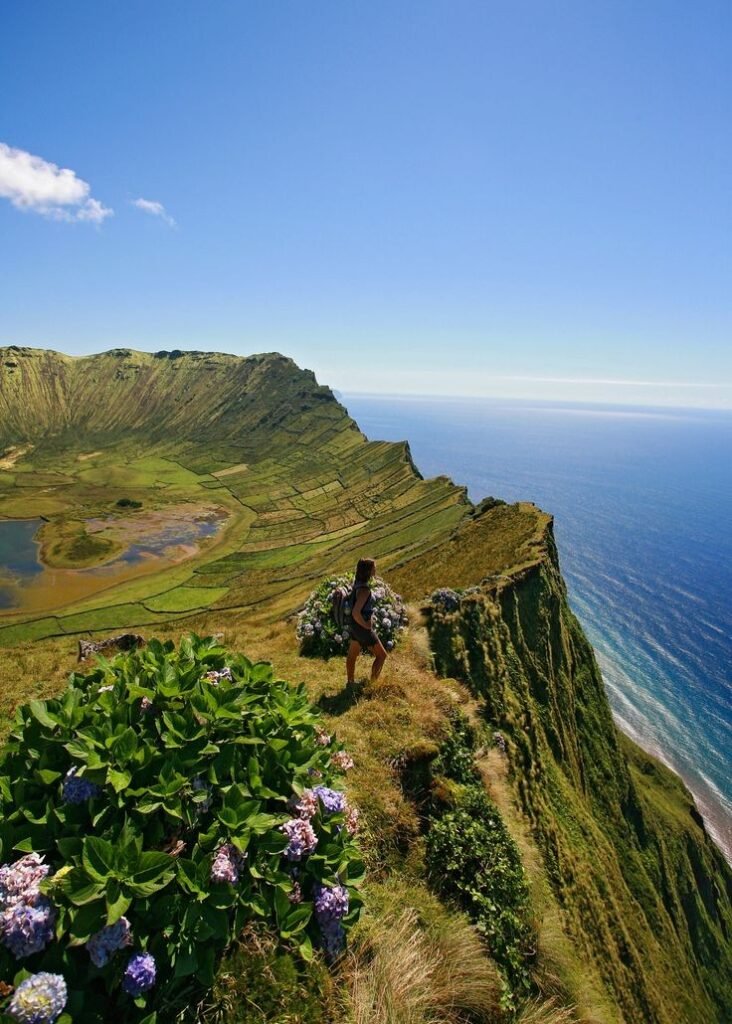
Pico Itinerary Day 1
Ascending Piquinho – the Pico mountain. It’s such an amazing experience I wrote a separate article about it.
Note that weather in Azores can be quite warm in the summer and Pico is one of the blackest islands in archipelago. Meaning it also gets warmer than other islands. So having a bathing suit and a towel with you is a must for every day!
Pico Itinerary Day 2 (Southern & Western part)
If you’ve been climbing Pico Mountain the previous day then second day should have some more resting activities.
Lajes do Pico: whale and dolphin watching
Different types of cetaceans live in the Azores. Some are residents, others are on their migratory routes depending on the season. Observing whales and dolphins in their natural habitat is one of Pico’s star activities. Seriously, they have by far most observations compared to all other islands.
There are rules for respectful whale watching; approaching the animals with reduced and constant speed, a maximum of 3 boats, never less than 50 meters, and never more than 15 minutes with the same animal. Generally, most agencies stick to those rules, but there will always be some, whose conduct goes against them.
We trusted Aqua Acores and were not disappointed. Their quiosk is just in the centre of Lajes by the bus stop.
The whale-watching tour lasts around 3 hours. A marine biologist will be with you in the boat and will explain lots of intersting information about the cetaceans you’ll see. Everyone hopes to see a sperm whale or some other large whale during the tour. Adjust your expectations – an animal in their natural habitat is a lottery. The animal itself decides whether it comes to greet you or not. Almost all operators advertise that they encourage you to do the tour again for free if no cetaceans are sighted, but it is practically impossible not to see dolphins so in practice that clause is more marketing than anything else.
If you wish to have your reservation booked and paid for in advance, we recommend this tour.
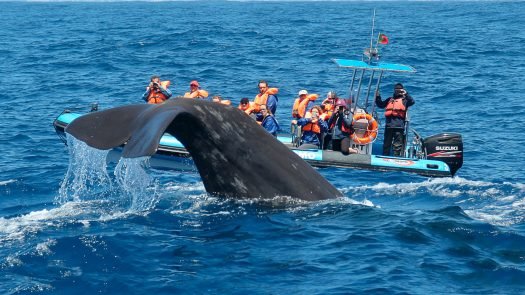
Pastelaria Aromas E Sabores
After the whale watching tour head to this lovely caffe and try their bombas volcanicas („volcanic rocks“) and bolo baleeiro („whale cake“). Enjoy the pastry while reviving your memories of what you just experienced!
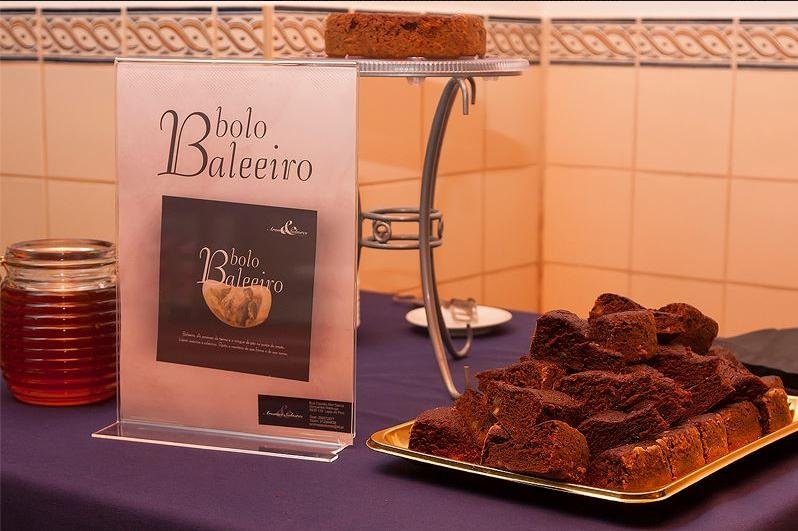
Museo dos Baleeiros – the whaling industry
I highly recommend you visit Museu dos Baleeiros. You can either join a tour or visit the museum on your own.
In the past, whales weren’t just observed, they were hunted. Whaling was a very important economic activity in the Azores, especially on Pico. The numbers are shocking (will not reveal them here, but you’ll find out a lot of information in the museum) and it wasn’t until 1987 that the last sperm whale was hunted on the island of Pico.
They have a short documentary to watch, recorded in the 70’s, about whaling on the island and what it meant for them back then.
Why whaling? Products derived from sperm whales and other whales were oils for lighting, lubricants (mainly for export) and various types of flour (made from whale bones). It is a very nice museum, but also a visit where you will swallow dry many times, especially after having greeted the beautiful and majestic cetaceans in their Atlantic home.
Museum entrance fee is 2€ for an adult and reduced price for child. Taking a guided tour around the museum is free of extra charge.
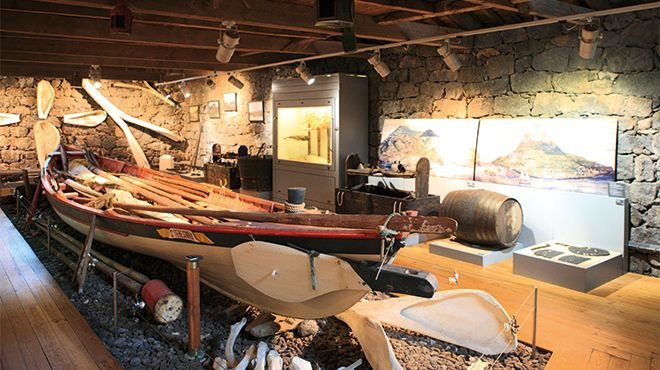
Grab a Lunch at Espaço Talassa or at Restaurante O Lavrador
Both are great options for a lunch, with Espaço Talassa being located in the main square (they offer food from the menu) and O Lavrador being located a few minutes drive out of town (they offer buffet, which means it’s all you can eat for 15€ with drinks included).
Dip in a natural lava pool?
If you feel like a refreshing in the ocean, there is a nice natural lava pool in Lajes. It’s more open and larger than most you will find on the island, and with luck, you might even be able to spot a dolphin in the distance!
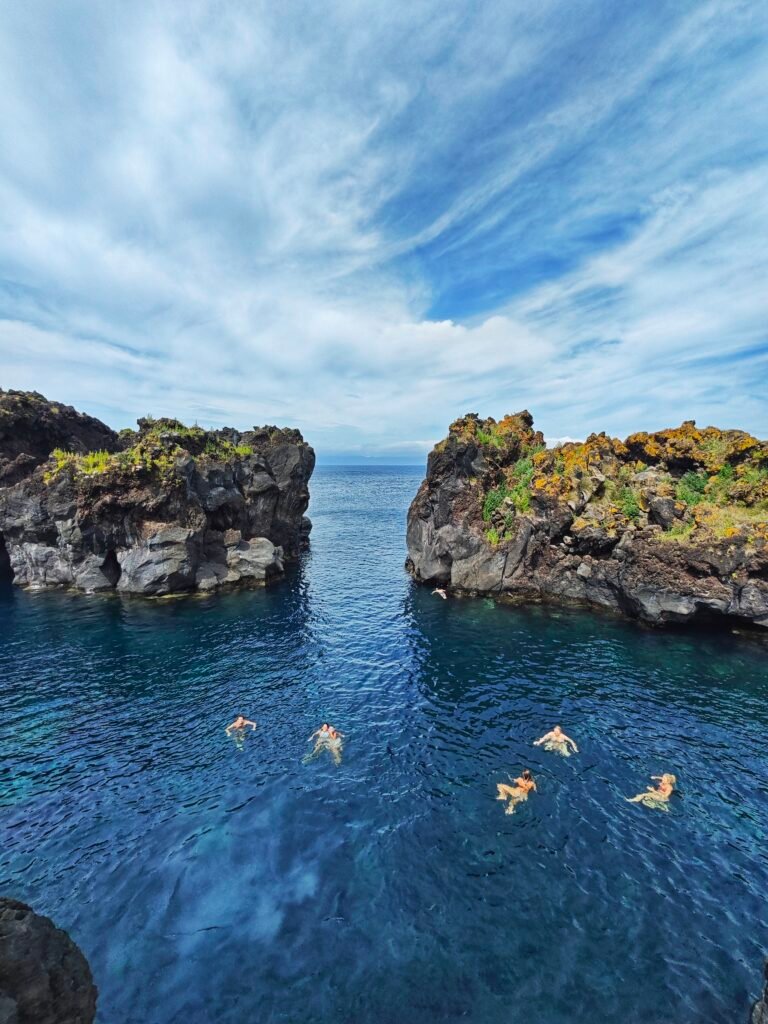
Gruta das Torres
Gruta das Torres is the largest lava tube in Portugal, with a length of 5150 metres. It is estimated it was formed about 1500 years ago during a volcanic eruption.
This visit must be booked in advance as spaces are limited – the tour is guided. The cave is absolutely one of a kind in Portugal.
The visit follows the cave over a length of 450 metres and it takes about 1 hour.
Entry fee is 10€ and it includes everything for safe exploration of Azorean cave system. More about opening times, guided tours and bookings here.
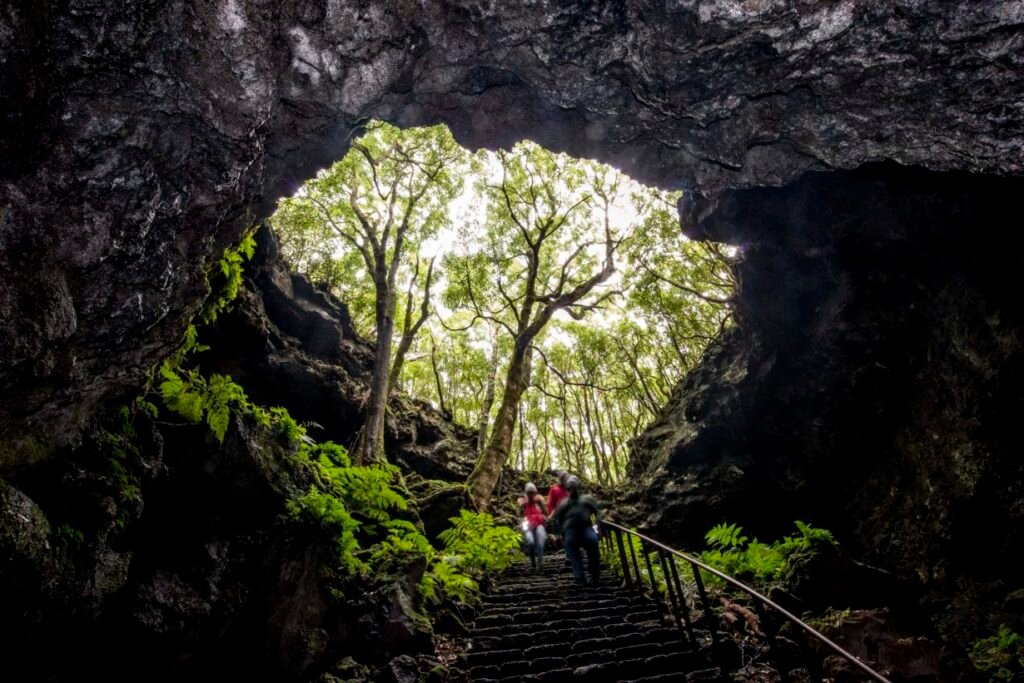
Madalena
Even though Azorean cities usually aren’t the most interesting thing on each island, you can still find some things to do. Madalena is first and foremost a port. It has some excellent restaurants to try out, but besides that there isn’t much to do. Still, you can enjoy the town for a little bit. You can visit the main church, the permanent Exhibition of Sperm Whales and Squids, Areia Funca Bathing Area, or the famous Cella Bar. Perhaps stop at the Azores Wine Company for a glass of excellent Pico White Wine.

This day doesn’t have as many activities (or hikes), taken into consideration you ascended Piquinho the previous day. If you skipped Piquinho then by all means use the day to it’s fullest.
Pico Itinerary Day 3 (Northern & Eastern part)
A day to remember! You can always do whatever you want in this itineraries. I’ll give you some sugestions and you pick whatever you’d like to do.
In the morning it’s usually wiser to do a hike than in the afternoon – air is fresher, not so many people on trails and you’ll be fairly hungry by lunchtime. And taking a dip in one of the lava pools will be a must!
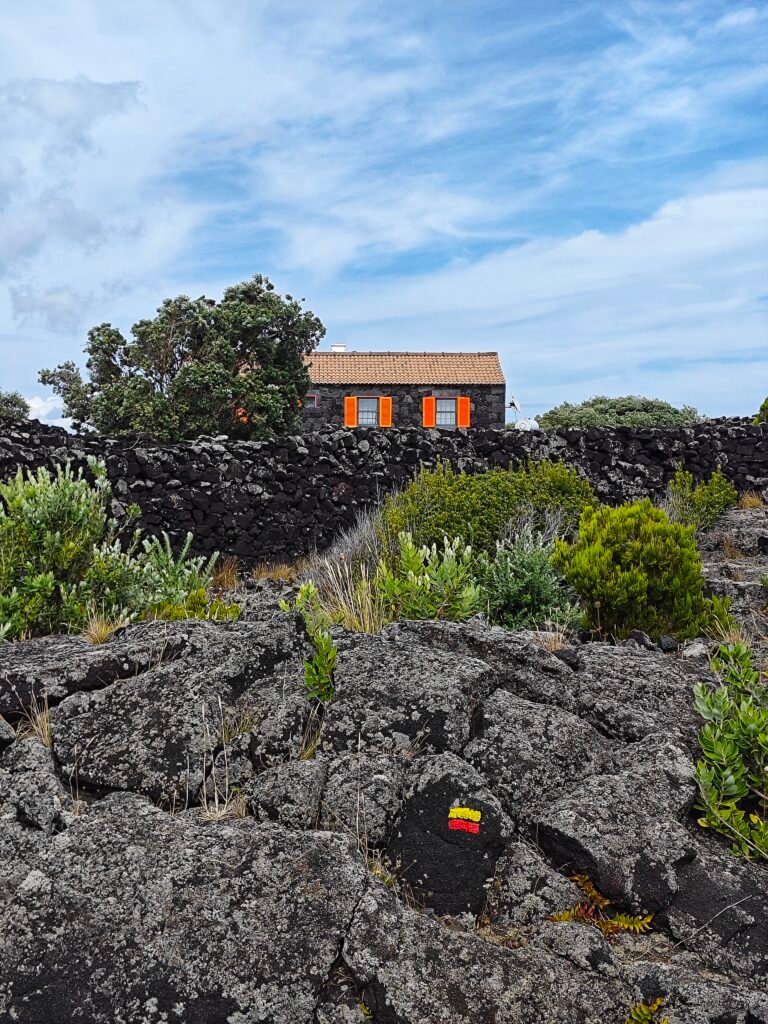
Ponta da Ilha Trail (PR3PIC)
By far one of the best trails on Pico we’ve done. It’s a linear trail, A – B, 6 kilometres long. Average trek time is 3 hours.
The official start of the trail is in Calhau, but you can cut around 1,5 kilometres and start in Cais do Galego. The trail goes just by the sea, on sharp lava rocks. It is well marked, uneven and therefore marked as a difficult trail. Strangely – it doesn’t have any ascends, but the surface where you walk is so difficult you end up mentally tired. Still, it is so worth it!
The ending point is Ponta da Ilha. You’ll see the lighthouse from far away – do not walk across it’s gardens and courtyard! The trail will take you around the lighthouse. The lighthouse is a private area.
Ponta da Ilha is a nice little village with natural lava pools (of course). If hungry I highly recommend restaurant “Ponta da Ilha” – insanely delicious seafood!
If you have a car you could save this trail for some other time or do it with a taxi or a tour. Or you can simply do only some part of the trail and return to your vehicle whenever you’d like. The trail is, however, the most interesting right in the middle and it changes a lot.
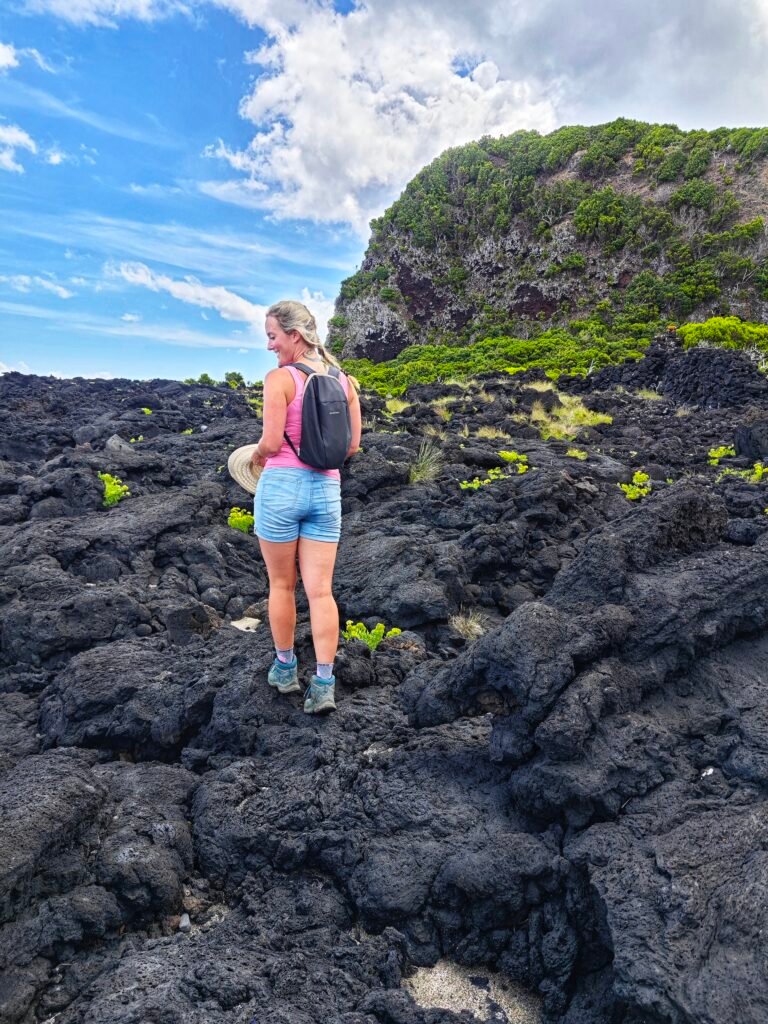

Take a dip in the pools of Sao Antonio or grab a Lunch in Sao Roque
Sao Antonio is a wonderful spot to have a swim. They have normal pools and natural pools as well, but you’ll also find a fantastic 6-meters-high cliff where people jump off into the ocean. There are toilets and showers. The parking lot is just by the road. All free of charge. There’s a bar across the road.
In Sao Roque you’ll find the whalers museum and a great marina. You can grab a snack or lunch at any of the restaurants. There are natural pools in Sao Roque as well (at the time of our last visit there was an enormous amount of sea grass all over pools, so we skipped a dip here).
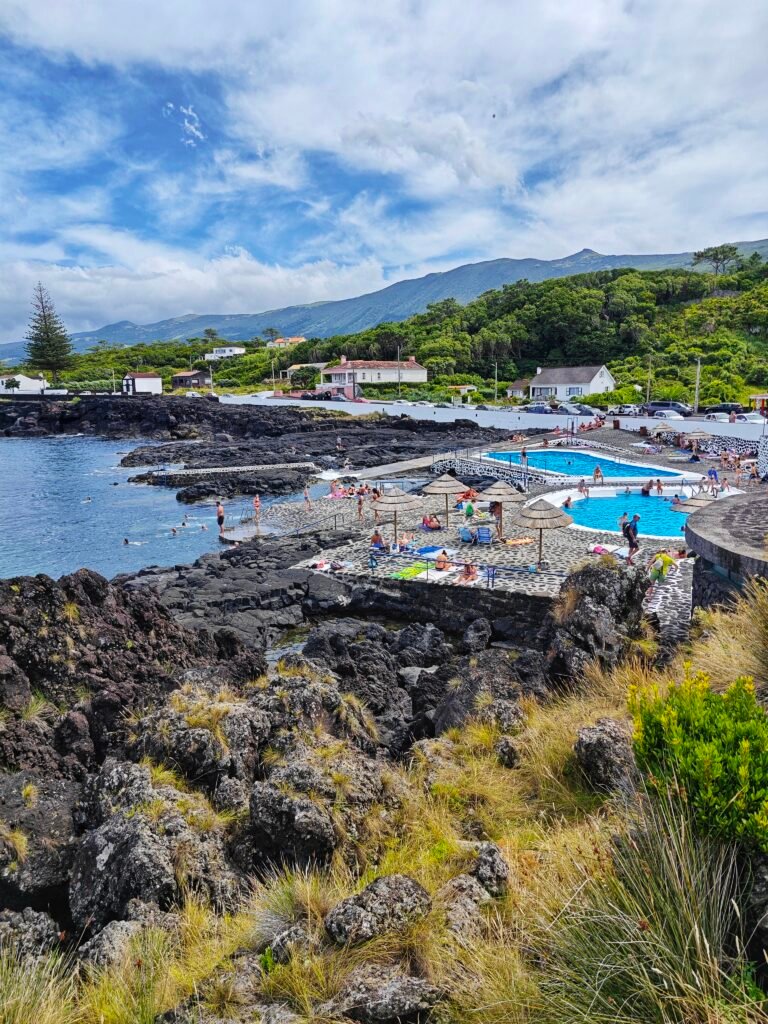
Cachorro
In the small village of Cachorro („puppy“ in Portuguese) you can see a volcanic rock in the shape of a dog’s head looking out to sea. But that’s not the main attraction.
Cachorro is a part of the Protected Landscape of the Pico Vineyard Culture. In fact, it is connected to the other two coastal towns, Lajido and Cais do Mourato, through the so-called Caminho da Costa, which we highly recommend you take. Walking from Cachorro to Lajido is like to walk on the history of the youngest island of the Azores with the sea as a companion.
You will walk among some beautiful black-white-red houses surrounded by vineyards.
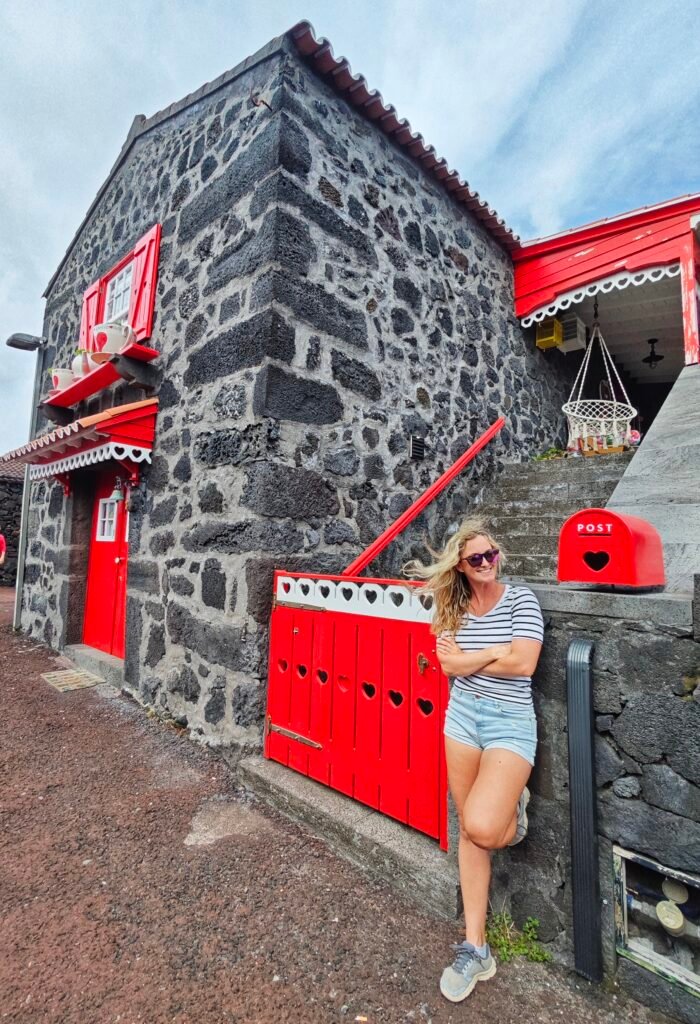
Lajido
Lajido is a village where the volcanic black contrasts with the lava red. the house stylings are stunning. Pico island being the youngest of the nine Azorean islands (estimated to be ‘only’ about 250,000 years old) has had four recent eruptions (between 1500 and 1700). These recent eruptions, whose lava flows modified the terrain, were called mysteries by the local people because they were incomprehensible and mysterious and could not be explained. When people turned to the priests asking what they were about, they answered that they were “mysteries of the Lord” and so these eruptions were baptized as such in the entire archipelago. There are 4 mysteries that correspond to these 4 recent eruptions and Lajido is part of one of them, the mystery of Santa Luzia, whose eruption occurred in 1718.
Take a stroll through the village and its vineyards. Visit the Casa dos Vulcões where you’ll not only walk out with understanding of everything you see on the surface of the island(s), but you can also use their two simulation centers. One will take you to the center of the Earth and the other one will shake you like an earthquake would. Entry fee is 4€.
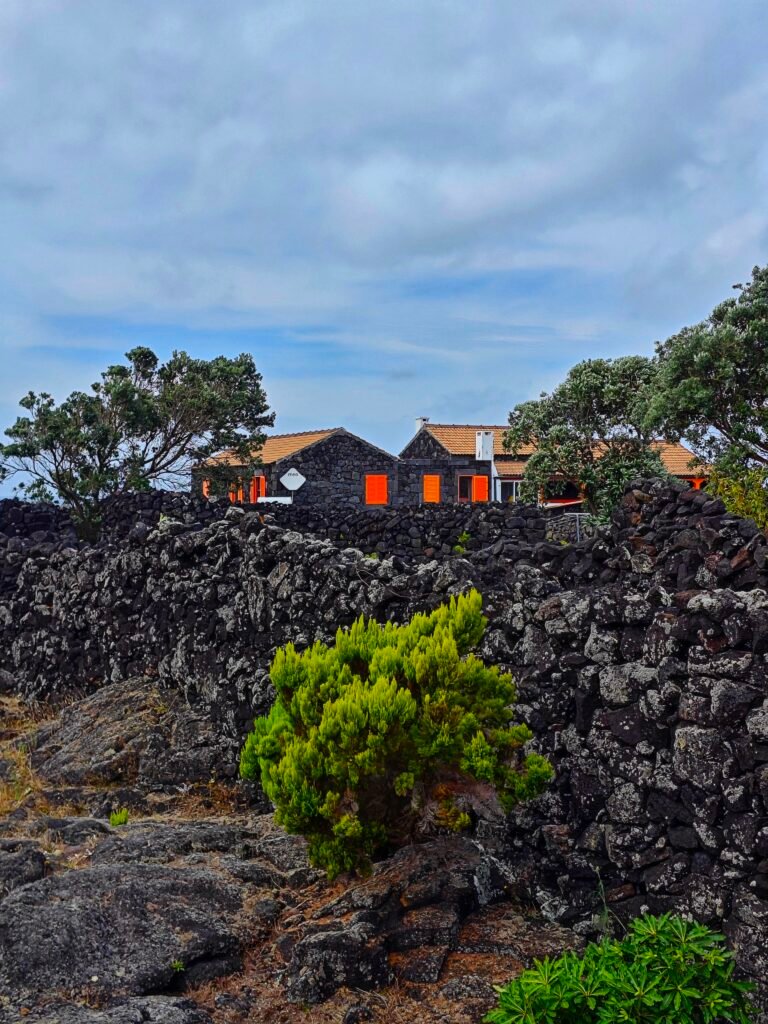
Santana – Lajido Trail (PR10PIC) – optional
If you have energy and some extra time there’s a nice trail starting (or ending) in Lajido. Walking past endless vineyards, Mount Pico in the distance, some forest, and a lot of ocean – calming.
The trail is linear but feel free to turn around at any point. The whole trail is 8.7 kilometres long and would take you 2,5 hours in total (one way since it’s linear).
The trail is well marked with yellow-red stripes. You’ll see them clearly on black lava rocks. What’s amazing on this trail (on Ponta da Ilha Trail PR3PIC as well) are solidified flows of lava, so clearly visible it’s just stunning.
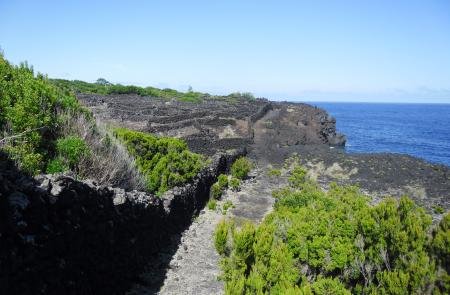

Pico Itinerary Day 4 (Central part)
Finishing the island strongly – with the most remarkable parts.
Estrada Transversal (EN3) and Lagoas
Said to be the most beautiful road in Portugal and I couldn’t agree more. It’s a 23-kilometres-long road linking Madalena and São Roque. It’s also the longest straight road in the Azores – and by straight I actually mean straight. 9 kilometres long straightness.
The EN3 passes through the interior of the island. You will have Pico mountain by your side all along. Eventually the most beautiful lakes on the island will start to appear – Lagoa do Caiado, Lagoa do Capitão, Lagoa do Paul, Lagoa do Peixinho, Lagoa Rosada and Lagoa Seca.
You can stop at any of the lakes, enjoy the views and serenity. The further you drive, the more São Jorge will be visible across the ocean.
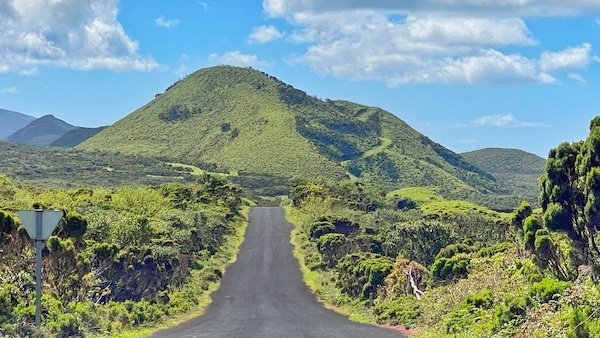
Furna do Frei Matias – optional
Optional and not for the light-hearted.
The cave is named after a hermit, Frei Mathias („brother Mathias“), who lived in this cave in fear of pirates. The cave is 1,000 meters long, but most of the cave is difficult and caving equipment and experience is necessary. However, the entrance area is easy to visit and because of its location (on Estrada Transversal) very popular. It’s also free of charge.
Lagoa do Capitão
Probably the most famous lake on the island.
Not as vast and beautiful as some of the lagoons you will find on São Miguel, but it is still a site to be seen with Mount Pico reflecting right nearby.
If you’re a hiker, this is where you start one of the most interesting hikes on Pico as well.

Lagoa do Capitão Trail (PR13PIC) – optional
Another insane linear trail. Starting from Lagoa do Capitão the first 2,5 kilometres of the trail are almost completely flat, on a gravel road. You’re walking past numerous Azorean junipers – they are so large you’d never guess it’s actually a juniper tree. The next 3 kilometres are the most fun. You’re descending 600 meters in one hour so that might be hard on your knees.
But the trail… pastures with gazing cows, barely visible trail on the grass, lush green forests, Azorean blueberries, grasped in a hug of mother Nature all along. Just wow.
The official end of the trail is in Sao Roque, but if you can have a taxi arranged then they can pick you up at termoelectrica. It will save you additional 3 kilometers that are not that interesting.
This is not a trail where you’d leave your car at the parking lot and just go make a few kilometers. As mentioned, first few kilometers are basically on a gravel road so not as interesting as one’d hope. But when it gets interesting the descend is so steep you’d make yourself a hard work coming back up to your vehicle.
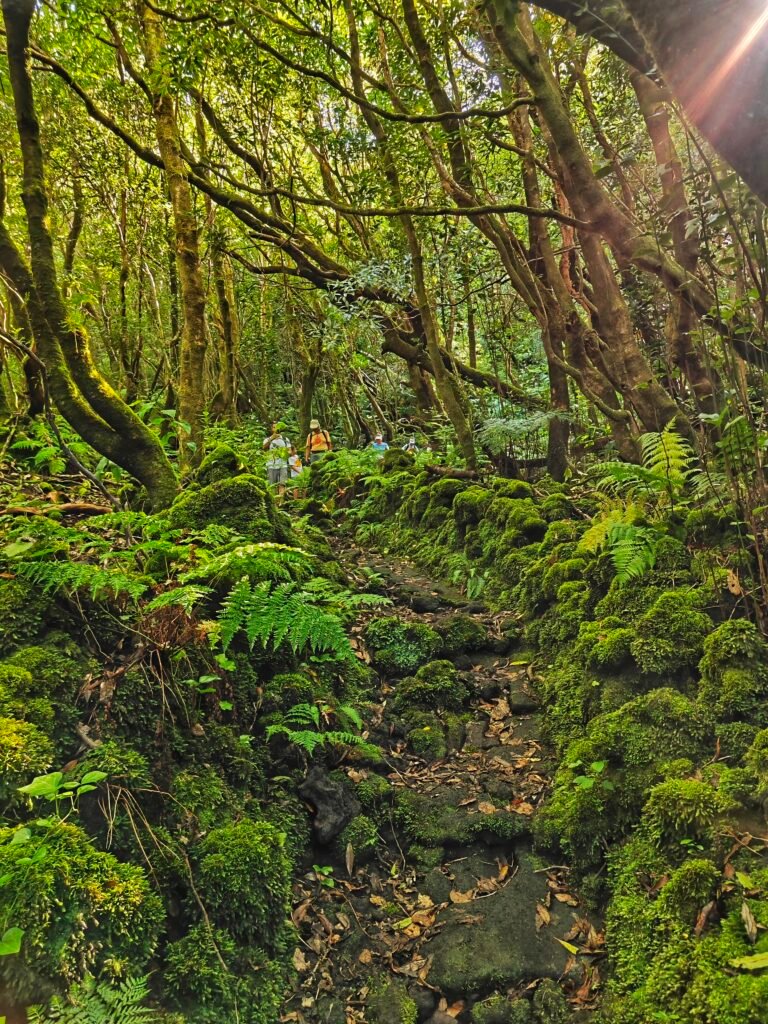
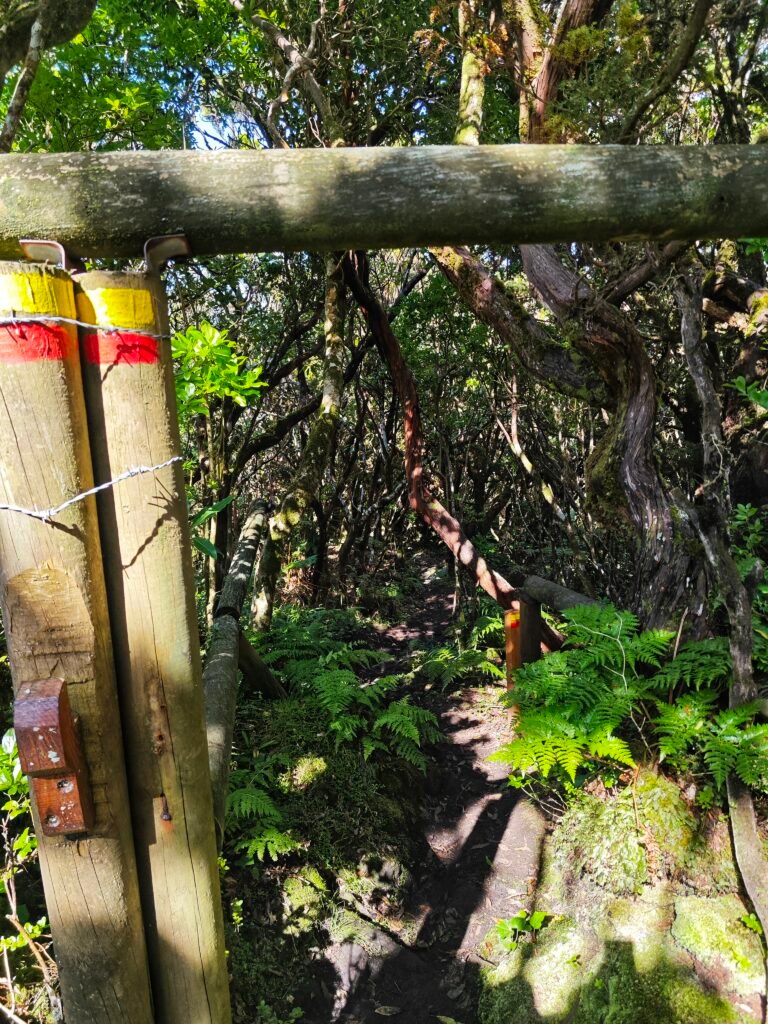
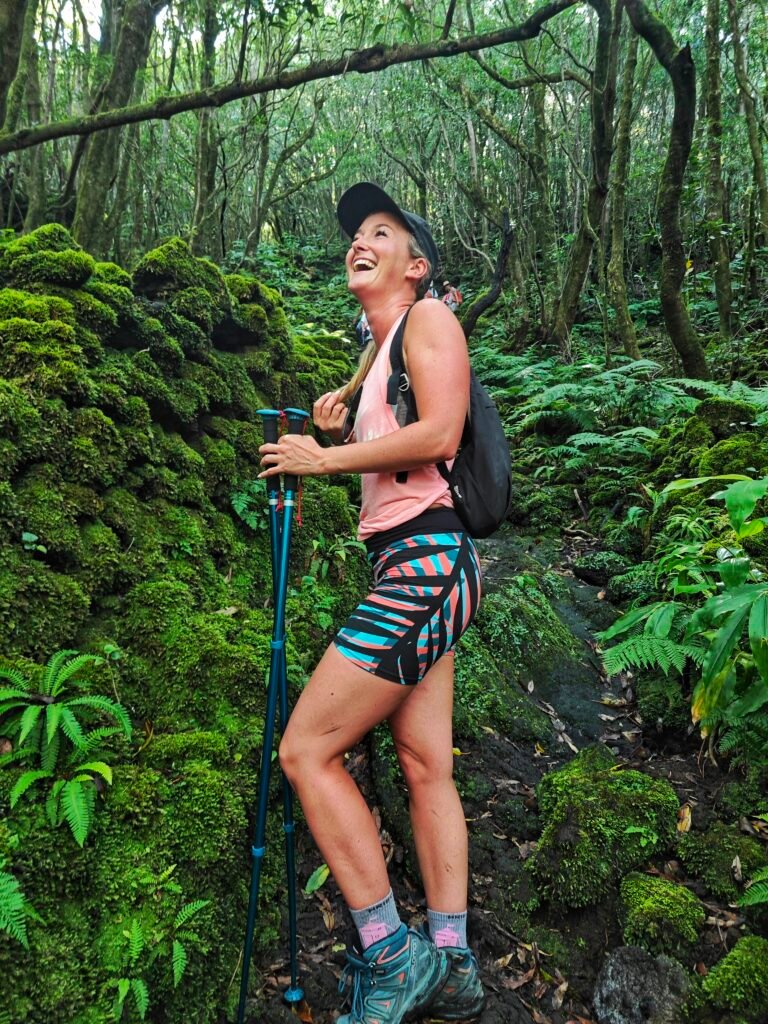
You can finish this day with another visit to São Roque or Sao Antonio natural pools.
NOTE! The central part of the island (Estrada Transversal, Lagoas and trails) doesn’t have any restaurants or shops. There’s only nature. If you’re planning on hiking you’d be wise to bring food and beverages with you.
To summarize everything…
You could definitely see the main attractions in Pico in fewer days, but even stopping for a swim in one of the gorgeous natural lava pools has its charm.
With all of that said we think you’re ready to visit Pico now 🙂 if you need further assistance with planning your trip don’t hesitate to contact us and get yourself personalised travel advice.
If you had a look at our itinerary plans for other Azorean islands you can see that you need quite some time to enjoy Azores fully. To save the time you can respond when wander calls and join us in one of our group adventures!

